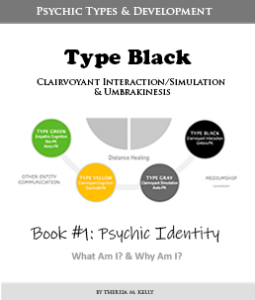- What Am I? (Type Black)
- Psychic Ability (Type Black)
- Dreams Impressions & Hallucinations (Type Black)
- Clairvoyant Interaction (Type Black)
- Trance Mediumship (Type Black)
- Channeling (Type Black)
- Physical Mediumship (Type Black)
- Clairvoyant Simulation (Type Black)
- Input CS (Type Black)
- Output – Probability Shifting (Type Black)
- Output- Historical Shifting (Type Black)
- Changing The Past (Type Black)
- Intention (Type Black)
- Intention #2 (Type Black)
- Adaptive or Directive? (Type Black)
- Adaptive or Decisive? (Type Black)
- Input or Output? (Type Black)
- Trance Mediumship or Channeling? (Type Black)
- Your Sources (Type Black)
- People, Places, Objects & Ideas (Type Black)
- People, Objects & Events (Type Black)
- Precognition & Probability Shifting (Type Black)
- Contemporaneous Input & Real-Time (Type Black)
- Postcognition & Historical Shifting (Type Black)
- Episodes (Type Black)
- Experience Modes (Type Black)
- Other Terms for CI and CS (Type Black)
- You Are Not Alone: CS & CI (Type Black)
- Magical Thinking & Psychic Confusion (Type Black)
- The Difference Between Types of ESP (Type Black)
- The Difference Between Types of ESP II (Type Black)
- Seriously? (Type Black)
- Having Doubts: CS & CI (Type Black)
- Psychokinesis (Type Black)
- Forms of Psychokinesis (Type Black)
- PK or CS Healer? (Type Black)
- Science Crash Course (Type Black)
- Umbrakinesis (Type Black)
- Umbra-PK Subtypes (Type Black)
- Umbrakinesis Part II (Type Black)
- Normal or Paranormal? (Type Black)
- Light or Thermal Healer? (Type Black)
- Umbra-PK & Physical Mediums (Type Black)
- Did You Know You Are Not Alone? (Type Black)
- Having Doubts? (Type Black)
- One Last Question (Type Black)
INPUT CS
 Through this type of clairvoyance, the experiencer does not usually “know,” the information received from their environment, neither are they aware that their needs are the source of their luck, good fortune, or intuition. This is often due to the very hard to notice effects and the person’s more logical way of thinking.
Through this type of clairvoyance, the experiencer does not usually “know,” the information received from their environment, neither are they aware that their needs are the source of their luck, good fortune, or intuition. This is often due to the very hard to notice effects and the person’s more logical way of thinking.
There are two main features of clairvoyant simulation: input, where the experiencer receives a helpful effect, and output, where the experiencer creates a helpful effect in their environment.
 Input allows the universe to share information with an experiencer that may help to meet their present needs. This information may involve how things work, if things work, or how the experiencer can make things work, or figure out if something can work.
Input allows the universe to share information with an experiencer that may help to meet their present needs. This information may involve how things work, if things work, or how the experiencer can make things work, or figure out if something can work.
Information received is usually added to information already known by the experiencer, and as I mentioned before, the information is usually received without the experiencer knowing it did not come from them.
Because of this, ideas appear to be the result of the experiencer’s own problem-solving or decision-making skills.
In other words, the information is usually seen as a self-decided “aha!” or “eureka!” more so than involving the help of their environment. An aha! or eureka! effect are moments when a person suddenly understands something that they could not understand before, like a problem or idea. However, with these effects the person can look back at their thought process and see how they came to their conclusion through subconscious guessing based on the information they already knew.
In other words, your subconscious mind was working overtime to solve the problem based on what information it had to work with, and what it could guess based on what it already knew.
The opposite is true with clairvoyant simulation input, where the conclusion is reached, but the experiencer is not quite sure how they came to their conclusion.
 The best way to tell the difference between clairvoyant simulation input and eureka! or aha! effects is by seeing if you can figure out how you came to your conclusion or solution. This is because input shows you information that you did not know before, or directs you to answers that you did not have enough information to understand before.
The best way to tell the difference between clairvoyant simulation input and eureka! or aha! effects is by seeing if you can figure out how you came to your conclusion or solution. This is because input shows you information that you did not know before, or directs you to answers that you did not have enough information to understand before.
If you find an answer but cannot find all the steps leading back from the solution to the original problem, your conclusion may be the result of clairvoyant simulation input.
But, if you find an answer, but CAN find all the steps leading back, it was probably a eureka! or ah! effect.
Either way, it’s intuition, except one is purely the product of the mind and internal information, while the other involves the mind and external information.







